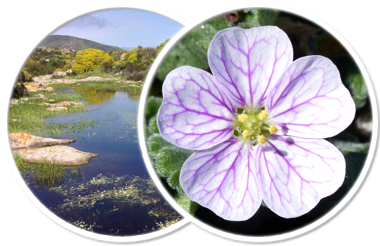Study area
The island of Asinara is a National Park and a Marine Protected Area since 2002, because of its great naturalistic and historical importance. It is also part, with the nearby Isola Piana, of the Natura 2000 network. Situated in the extreme north-west of Sardinia, the island has an elongated shape, with a cliff coast in the west and low coasts with small sandy coves in the east, a coastline of c. 100 km, and an area of 51.92 km2. Maximum length is 17.5 km, maximum width 6.5 km, and minimum width c. 250 m. From the administrative point of view, the island belongs to the municipality of Porto Torres (Province of Sassari).
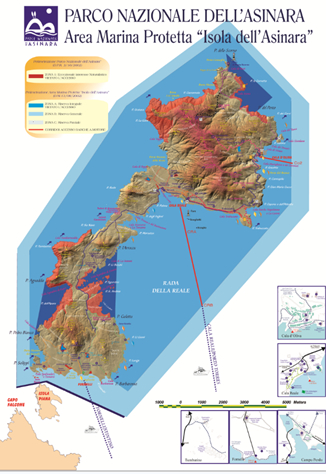
The Asinara National Park.
Human settlement dates to the prenuragic period, with the ‘Domus de Janas’ of Campu Perdu, but the first real colonisation occurred in medieval times, with the construction of a monastery at Sant'Andrea, and of the ‘Castellaccio’ at Punta Maestra Fornelli, which was part of a defensive system including the towers of Trabuccato, Cala d'Oliva and Cala Arena.
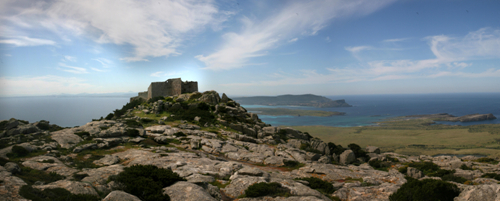
The Castellaccio.
Between 1600 and the end of 1800 the island was inhabited by a community of shepherds and fishermen. In 1885, the population was removed following the establishment of the Primary Lazzaretto of the Kingdom of Italy and of the penal colony. During the First World War, the island became a prison camp for thousands of soldiers of the Austro-Hungarian Empire. Recent history is characterized by the presence of a super-prison hosting members of the camorra, the mafia and the red brigades, which was closed in 1997, when the National Park was established.

Cala d’Oliva.
The prevalent geological substrate consists of metamorphic rocks of Paleozoic origin, but there are also granite outcrops and alluvial formations confined in small areas. The main peaks are Punta Scomunica (408 m), Punta Maestra Serre (391 m), and Punta Maestra Fornelli (265 m). The hydrographic network is very poor, with a single perennial stream called Rio Baddi Longa. The bio-climate is of the oceanic-Mediterraneanean type.
The floristic list, which includes 701 infrageneric taxa, is based on that of Bocchieri (1988), supplemented by some more recent reports. For more details on the informatic structure of this Portal see Martellos & Nimis (2015).
The vegetation is dramatically degraded as a result of human activity: fire, overgrazing, intensive and extensive farming carried out during 112 years of presence of the penal colony, and the impact of cattle grown wild after its closure, have resulted in the disappearance of some plant communities and compromised the status of those present. However, the vegetation still comprises several plant communities which are unique worldwide.
The forest, that has disappeared almost everywhere, is dominated by holm oak (Quercus ilex), and still survives only in the northern areas of the island, on metamorphic rocks, between 150 and 200 m. The maquis that replaces the forest consists of Pistacia lentiscus and Cytisus laniger.
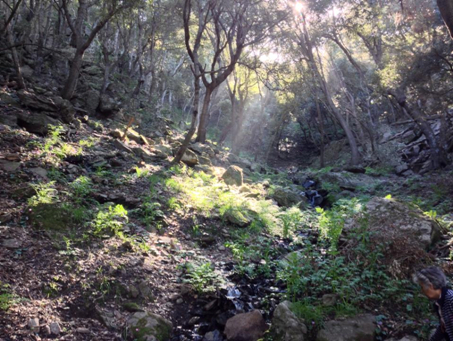
The residual holm oak forest at Elighe Mannu.
Other scrublands are present on Paleozoic schists in the southern sector of the island and on granite in the central portion, where the potential vegetation is mainly represented by a community of juniper and spurge (Juniperus phoenicea and Euphorbia characias), which also appears in other areas of the island, particularly in the coastal stretch within 100 m from the coastline. The most impoverished communities are dominated by the mastic tree (Pistacia lentiscus) and by Euphorbia dendroides.
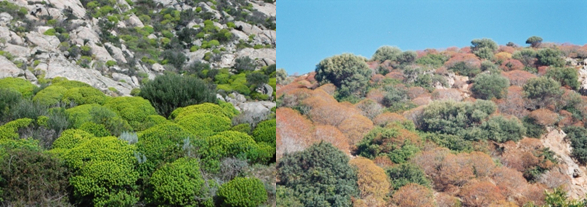
Community with Olea europaea var. sylvestris and Euphorbia dendroides.
The garrigue is represented by a community of Euphorbia pithyusa and Helichrysum on deeper soils, while on eroded soils of the western side of the island there is the typical formation dominated by Centaurea horrida.
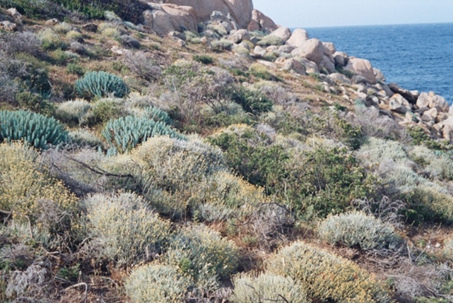
Garrigue with Euphorbia pithyusa and Helichrysum.
The last stage of degradation is a herbaceous community with Dactylis glomerata subsp. hispanica, Camphorosma monspeliaca, Catapodium balearicum, Filago tyrrhenica, Senecio leucanthemifolius and Nananthea perpusilla, which is biogeographically important for the presence of the endemics Nananthea perpusilla and Filago tyrrhenica.
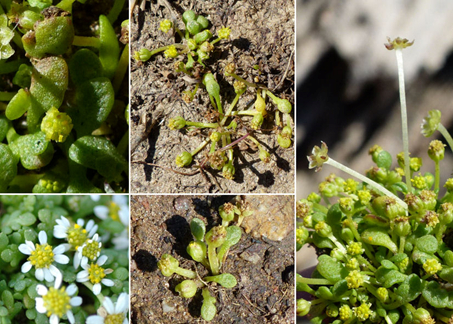
Nananthea perpusilla.
The inland areas of the island, at altitudes above 200 m, are occupied by woodlands with Olea europaea var. sylvestris and Asparagus albus, which are the predominant vegetation in the southern (Castellaccio) and northern (Cala d'Oliva) portions of the island. Less species-rich communities are the scrublands dominated by Cytisus laniger and Euphorbia dendroides, the garrigue with Cistus monspeliensis, especially favoured by fires, and the grasslands with Dactylis hispanica and Tuberaria guttata.
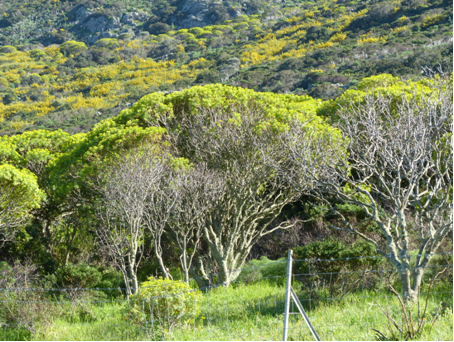
The community dominated by Euphorbia dendroides.
The vegetation reached by salt spray from the sea that grows in cracks of the rocks, well represented on all the coasts of Asinara, consists of communities with Crithmum maritimum and Limonium acutifolium. In the inner areas and higher up on the cliffs there is a typical thorny-cushions community dominated by Centaurea horrida.
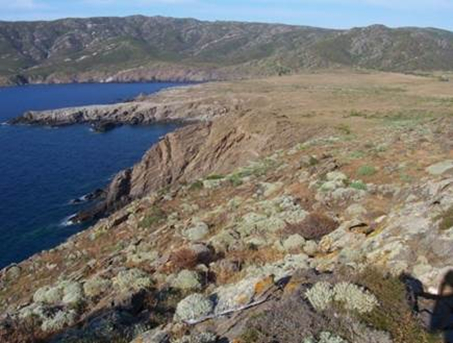
Rocky coast west of Campu Perdu.
The clearings with dry bare soil between the thorny cushions are occupied by communities dominated by the annual Filago tyrrhenica, a Sardinian endemic. In somewhat more humid sites, a community develops which blooms in spring, dominated by Nananthea perpusilla, another endemic of Sardinia and Corsica.
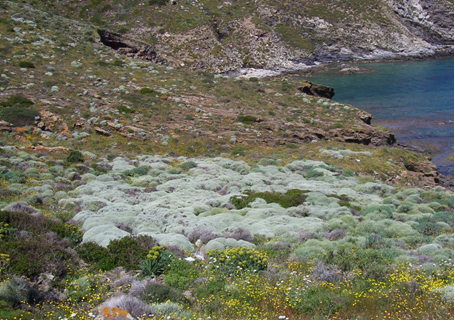
Garrigue with Centaurea horrida (west of Punta sa Nave).
The vegetation of sandy coasts, mainly distributed in the eastern part of the island, is represented by a community dominated by Salsola kali and Cakile maritima and by associations of perennial grasses such as Sporobolus virginicus and Ammophila arenaria, among which also the endemic Silene succulenta subsp. corsica is rarely present.

Litoral sand dunes at Cala San Andrea.
Behind the dunes there is often a series of depressions which are flooded in the winter months, occupied by communities with the endemics Limonium glomeratum and Limonium laetum. On sandy substrates which are humid most of the year, on the edge of temporary ponds and ditches behind the dunes, there are populations of Juncus maritimus and small shrubs of Tamarix africana.
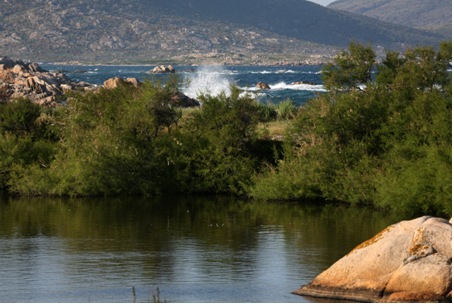
Tamarix africana near Cala S. Andrea.
In wet sites such as small seasonal ponds, reservoirs, springs, or small streams, hygrophilous plants grow, such as Callitriche stagnalis, Eleocharis palustris, Isolepis cernua, Agrostis stolonifera, Bellium bellidioides and Mentha pulegium.
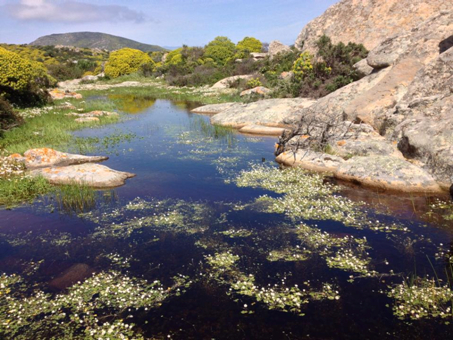
Temporary ponds in spring, with the bloom of Ranunculus peltatus subsp. baudotii.

Temporary ponds at the beginning of summer, with the bloom of Crassula tillaea.
Scrublands with Vitex agnus-castus are found behind the dunes and along the humid watersheds, together with sporadic small woods of Ulmus minor (La Reale) or Populus alba (Cala d'Oliva).
On rocky ridges in upland areas there are populations of Arenaria balearica, Cymbalaria aequitriloba, Selaginella denticulata, Anogramma leptophylla, Asplenium obovatum and Polypodium cambricum, forming communities with an important biogeographical value.
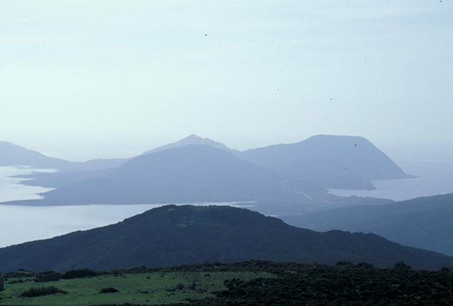
The highest hills of the Island, seen from Punta Scomunica.
Literature
- Angius V., 1833 - Asinara – In: Casalis G.: Dizionario geografico-storico-statistico-commerciale degli Stati di S.M. il Re di Sardegna, 3: pp. 414-415, Torino.
- Arrigoni P.V., 1982 - Le piante endemiche della Sardegna: 98 Bryonia marmorata Petit. - Boll. Soc. Sarda Sci. Nat., 21: 333-337.
- Arrigoni P.V., 1983 - Le piante endemiche della Sardegna: 121 Ranunculus cordiger Viv. ssp. diffusus (Moris) Arrigoni. - Boll. Soc. Sarda Sci. Nat., 22: 277-283.
- Arrigoni P.V.,1984 - Le piante endemiche della Sardegna: 146-Silene corsica DC. - Boll. Soc. Sarda Sci. Nat., 23: 249.
- Arrigoni P.V. & Diana S., 1985 - Le piante endemiche della Sardegna: 172: Limonium glomeratum (Tausch) Erben. - Boll. Soc. Sarda Sci. Nat., 24: 295-300.
- Arrigoni P.V et al., 1976-1991 - Le piante endemiche della Sardegna 1-202. Boll. Soc. Sarda Sci. Nat., 16-28.
- Barbey W., 1884 - Florae Sardoae Compendium. - G. Bridel, Lausanne.
- Biondi E., Diana S., Farris E. & Filigheddu R. - 2001 - L’ordine Limonietalia Br.-Bl. & O. Bolòs 1958 in Sardegna. - Fitosociologia 38 (2): 37-44.
- Biondi E., Farris E. & Filigheddu R. - 2001 - Il paesaggio vegetale della Nurra. - Fitosociologia 38, 2, Suppl. 2.
- Bocchieri E., 1988 - L’isola Asinara (Sardegna nord- occidentale) e la sua flora. - Webbia, 42: 227-268.
- Bocchieri E., 1993 - Aspetti floristici e vegetazionali in Asinara. Storia, natura, mare e tutela dell’ambiente., 151-174, Sassari.
- Bocchieri E. & Filigheddu R., 2008 - Aspetti floristici e vegetazionali. - In: Forteleoni C., Gazale V.: Asinara. Parco Nazionale. Area Marina Protetta: 129-151. Carlo Delfino Editore. Sassari.
- Camarda I., 1980 - Le piante endemiche della Sardegna: 70: Stachys glutinosa L. - Boll. Soc. Sarda Sci. Nat., 19: 261-267.
- Corrias B., 1977 - Ad floram italicam notulae taxonomicae et geobotanicae. 21: Nananthea perpusilla (Loisel) DC. - Webbia 31 (1): 43-48.
- Corrias B., 1978 - Le piante endemiche della Sardegna: 28: Leucojum roseum Martin. - Boll. Soc. Sarda Sci. Nat., 17: 263-266.
- Corrias B., 1981 -Le piante endemiche della Sardegna: 93: Nananthea perpusilla (Loisel.) DC. - Boll. Soc. Sarda Sci. Nat., 20: 282-286.
- Desole F., 1973 - Nuova estensione dell’areale sardo di Nananthea perpusilla DC. - Arch. Bot. (Forlì) 49: 123-134.
- Desole L., 1959a - Presenza di Nananthea perpusilla DC nella penisola di Stintino (Sardegna). Osservazioni critiche sulla distribuzione ed ecologia della specie. - Webbia 15 (1): 111-139.
- Diana Corrias S., 1978 – Le piante endemiche della Sardegna: 31: Limonium acutifolium (Reichenb) Salmon. - Boll. Soc. Sarda Sci. Nat., 17: 277-283.
- Diana Corrias S., 1983 - Le piante endemiche della Sardegna: 132: Romulea requienii Parl. - Boll. Soc. Sarda Sc. Nat., 22: 335-341.
- Domina G. & Arrigoni P. V., 2007 - The genus Orobanche (Orobanchaceae) in Sardinia. - Fl. Medit. 17: 115-136.
- Giglio N., 1970 - L’Asinara. Arti Grafiche Editoriali Chiarella.
- Martellos S., Nimis P.L., 2015 - From Local Checklists to Online Identification Portals: A Case Study on Vascular Plants. - PlosONE, 10, 3.
- Moris J.J., 1837-1859 - Flora sardoa (1-3). - Regio Typographeo. Taurini.
- Nardi E., 1984 – The genus Aristolochia L. (Aristolochiaceae) in Italy. - Webbia, 38: 221-300.
- Nardi E., 1985 - Sulla tassonomia di Aristolochia insularis Nardi et Arr. - Webbia, 39: 119-127.
- Nicotra L., 1906 - Una visita botanica all’Asinara. - Malpighia, 20: 284-289.
- Negodi G., 1926-1927 - La flora dell’isola Asinara. - Archivio Botanico, 2: 35-44 e 107-119, 3: 71-82.
- Pignatti S., 1982 - Flora d’ Italia, 3 vol. - Edagricole, Bologna.
- Pisanu S., Filigheddu R., Farris E., 2009 - The conservation status of an endemic species of northern Sardinia: Centaurea horrida Badarò (Asteraceae). - Plant Biosystems, 143: 275–282.
- Pisanu S., Farris E., Filigheddu R., García M.B., 2012 - Demographic effects of large, introduced herbivores on a long-lived endemic plant. - Plant Ecol. 213: 1543-1553.
- Pisanu S., Murru V., Farris E., 2013 - Anchusa crispa viv. subsp. crispa. - Inform. Bot. Ital. 45, 2: 319-390.
- Pisanu S., Farris E., Caria M.C., Filigheddu R., Urbani M., Bagella S., 2014 - Vegetation and plant landscape of Asinara National Park (Italy). - Plant Sociology 51, 1: 31-57.
- Rivas-Martìnez S. et al, 2001. - Biogeographic map of Europe (scale 1: 16.000.000). - Cartographic Service, University of Leon.
- Schmid F., 1933 - Beiträge zur Flora der Insel Sardiniens. - Mitt. Bot. Muss. Univ. Zürich.
- Valsecchi F., 1977 - Contributo alla conoscenza del genere Echium: 1. Echium della Sardegna. - Webbia, 32(1): 101-127
- Valsecchi F., 1978 - Le piante endemiche della Sardegna: 37: Erodium corsicum Léman in Lam. et DC. - Boll. Soc. Sarda Sci. Nat., 17: 313-317.
- Valsecchi F., 1978 - Le piante endemiche della Sardegna: 38: Genista corsica (Loisel) DC.- Boll. Soc. Sarda Sci. Nat., 17: 318-323.
- Valsecchi F, 1993 - Il genere Genista L. in Italia: Le specie delle sezioni Erinacoides Spach, Ephedrospartum Spach, Aureospartum sect. Nova. - Webbia, 48: 779-824
- Valsecchi F., 1995 - Indagini sistematiche, tassonomiche e corologiche nel gruppo ‘Silene colorata Poir., S. sericea All., S. canescens Ten.. - Boll. Soc. Sarda Sci. Nat , 30: 447-476.















